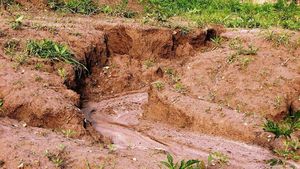Harsh winter weather conditions are significantly impacting military operations and drone activity within the Ukraine conflict. According to reports, temperatures have plunged and heavy snowfall has complicated combat actions for both Russian and Ukrainian forces.
Evgeny Romanov, the representative of the Kharkiv operational-tactical group, stated during a recent television marathon, "The snow is quite significant, and the frost has arrived, which prevents both our and enemy drones from flying for long periods. It’s hard for the enemy to fight under these conditions, as they are moving through territory where they have destroyed any possibility of hiding even for themselves."
These adverse weather conditions are affecting Russian troop maneuvers, making it difficult for them to operate effectively. Romanov noted, "Russian troops continue to attempt offensive actions using manpower, but the weather conditions hinder their ability to gather in large groups. This makes the occupiers vulnerable to Ukrainian military operations." He added, "On clear days without snow and clouds, we observe increased artillery shelling and drone attacks." This indicates a distinct shift where favorable weather leads to escalation.
Meanwhile, misinformation campaigns continue to complicate the situation. Andrey Yusov from the Main Directorate of Intelligence of the Ministry of Defense of Ukraine highlighted, "Russian special services are actively using social networks to spread fakes aimed at destabilizing Ukrainian society." These actions align with broader strategies to undermine confidence amid the conflict.
Yusov pointed out the absurd accusations by Russia claiming Ukraine plans terrorist acts against its diplomats as part of these disinformation efforts. "After the catastrophic decline of the authority of Russian propaganda resources, these functions have been increasingly assumed by Russian special services, which issue absurd fabricated news on a daily basis aimed at destabilizing Ukraine and its security forces.” This strategy appears to involve preparing provocations, not only within Ukraine but also against neighboring EU nations.
With significant periods of cold weather affecting military activity, the winter presents both challenges and tactical opportunities. The lack of mobility creates openings for counteractions by Ukrainian forces, and as the conflict continues, weather conditions remain pivotal to operational strategy.
While both sides grapple with the impact of severe winter weather on their military endeavors, the conflict is compounded by the toxic environment created by misinformation and propaganda. Yusov’s insights provide clarity on the extent to which psychological warfare intertwines with physical confrontations on the ground.
Finally, the situation remains fluid. The relentless rhythm of drone attacks, artillery shelling, and the freezing grip of winter drives home the stark realities of warfare. Nevertheless, as combatants adjust their strategies to navigate these new obstacles, the future of the conflict hangs precariously amid battling claims and counterclaims, underlined by the harsh Ukrainian winter. Citizens and military alike remain on edge, aware of the powerful role the weather plays, steering the course of their nation’s fight for sovereignty.



